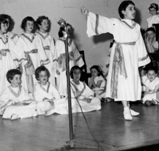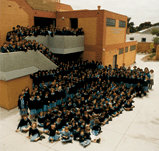Home
Letters
Article
Pictures
Soul Meetings
About
Contact

Chabad
School moves
to the city

Chabad School in Melbourne Australia - 1953
Jewish immigration to Australia occurred in accordance with the pattern one might expect, a slight trickle in Colonial days, increasing during the Gold Rush, after the California rush of 1849, swelling with refugees after the Second World War, and today, another influx, Lubavitch.
Lubavitch's involvement in Australia can be traced back to the when Moshe Zalman Feiglin went from Russia to Australia. He, and family settled in the farm - of Sheparton, where they worked as orchards. During those years the family maintained correspondence with Yechezkiel Feigin, previous Lubavitcher Rebbe's secretary. The purpose behind this outpost of Judaism did not become apparent for a long time.
The community of Melbourne slowly grew before the 1940's, and the most part concerned with tame kind of Jewishness. Beautiful synagogues were built during those years, but for the most part they inspired awe, not love. The massive influx of refugees after the war brought all the attendant problems of dislocation. Communities and families had been disrupted; destruction is always easier than reconstruction.
In those years the previous Lubavitcher Rebbe sent an emissary to Australia. He had a multifaceted task: to arouse compassion and funds for Jewish refugees still caught in DP camps and other transit locations in Europe, and also to encourage a strengthened commitment to Yiddishkeit amongst the established Jewish communities in Australia and amongst the newly arrived. In those days the difficulties of travel were greater than nowadays. The DC4 "Yankee Clipper" took 55 hours to fly the 12,000 miles from America to Australia, The main obstacle to building
Yiddishkeit in Australia was its great distance from the other Torah centers of the world. The potential for the development of Northeast America, Northwest Europe, and Israel is apparent. By virtue of the large numbers of Torah educated Jews, these areas have the ability to generate their own kind of Jewish culture and to answer their own educational and communal needs. In contrast, the small isolated community of Australia, and many other places for that matter, presented a formidable task.
With these latent, challenges pre- sent, Lubavitch began to leave the temporary settlement they had been obliged to make in Paris and to travel to various parts of the globe. Some went south to Australia, initially, in a settling down period, most of them went to the Feiglin family's farming settlement in Sheparton.
This served as an acclimatization center. The newcomers became acquainted with their surroundings, and of course with the "eccentricities" of the English language. Families were reunited and began to sort out what had happened over that previous decade of destruction. They prepared themselves for the future in their new homeland by learning Torah, keeping Mitzvoth, and setting up a small Talmud Torah (school).
As time went by, it became obvious that the small Lubavitch community of Sheparton would be able to achieve more in the "big city" of Melbourne. The masses of refugees looked to the existing Jewish organizations for guidance and help. While they did as much as possible, those organizations had developed ten or twenty years earlier in response to vastly different problems both quantitatively and qualitatively. Through no fault of theirs, there was a lack of direction, not helpful to the morale and enthusiasm of the Jewish refugees. These people were in the post-war reconstruction of their lives. Physical difficulties in the free world had been wrought by the war and its aftermath.
In Australia, expansion due to sudden population increase seemed to promise a bright future, at least economically. But the spiritual needs of these people were catered to by social clubs and "ceremonial Judaism", both of which were hardly equipped to handle the needs of the generation, and even less the needs of their children.
Lubavitchers came to the quiet frontier of Melbourne. With characteristic patience and enthusiasm, they proceeded to revitalize the community with the conviction that Jews can flourish as a nation and grow as people only with Torah-true Judaism. The heightened needs of people making a new life as they built up their physical and financial security emphasized their need for a concomitant strengthening of Jewish spiritual values. This strengthening is what Torah offers to Jews.
Lubavitchers in such a situation are well prepared to answer this call. The first project in Melbourne was the establishment of a school which would offer an undiluted Judaism to its students. Jewish education works with an axiom tested over 3000 years: Jewish education should help and does help a Jew to grow in his Judaism. This principle has maintained the integrity and high aspirations needed to keep Judaism alive and flourishing through adversity (G-d forbid) and through the more subtle dangers of prosperity.
The school was set up in in Balaclava, Melbourne, largely due to the untiring efforts of Rabbi Zalman Serebryanski. He attended to the spiritual and financial needs of the new "Yeshivah College", as the boy's school was named. He approached non-religious families to persuade them to enroll their children, and to explain to them that Jewish education is not a luxury. A school is not set up in a vacuum.
The gradual participation of the community was necessary. This entailed the settling down of hundreds of families. They were the evolving backbone of support for the school and its associated synagogue. Approximately 200 families are connected with the synagogue. It is a center for social activity as well as a place to pray and study.
The 50's were years of growth.

additions please E-mail us